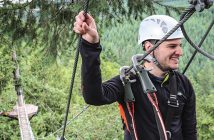Here’s how it works: a single lanyard attaches to the connector, which has two locks that interact with each other. First, a guest attaches the open, unlocked side of the connector to a transfer line, ring, or the next belay section. A pin located at the transfer point is pushed into a keyhole, locking that connected side of the carabiner and unlocking the other clip. The guest can then repeat the process to continue through the course.
“The beauty is the simplicity,” says Trevor Zinn, sales manager for distributor Preferred Safety Products and its Challenge Course USA division. “It’s really easy to understand because it’s carabiners, but it’s sort of foolproof because you have to click in and key out.”
The ICS Smart Snap Belay System also preserves a bit of the adventure for guests, leaving them responsible for clicking in and out with the pin key. “It still gives you the same feeling you were getting before, whether that was with a regular carabiner or another device. Plus, it’s easy to understand for the user, the trainer, and for the builder as well.”

Above left: Kanopeo’s Speedrunner continuous belay system was designed in 2007 so that children wouldn’t have to clip and unclip carabiners. Center: The ICS Smart Snap requires a “key” to unlock the carabiner-like attachment device and transfer between belay lines. Right: Koala Equipment’s Pouliz 2.0 pulley rides on a continuous belay line and allows customers to move from one obstacle to another, including vertical activities and zip lines up to 1,650 feet long, without having to manipulate any carabiners.
CliC-iT’s smart belay system utilizes two carabiners and a safety connecting system, which synchronizes the open/locked positions of the two carabiners so that the user cannot detach the lanyard connectors simultaneously. “The system integrates an exclusive magnetic detection of the lifeline, thus even greater safety while hooking,” says Henri de Rocca Serra, partner and director of sales and marketing.
Thanks to the system’s double wire design for the connector’s interconnection and a minimum of components, park owners and operators can perform their own maintenance and periodic controls. It does not require anchoring modifications, so it can be used on many existing routes. CliC-iT also offers add-ons, like its C-ZAM rings that further raise the level of safety and are said to greatly enhance handling, and the C-CONNECT for Tarzan jumps and vertical ascents.
“Safety systems are moving more and more toward ease of use and safety,” says de Rocca Serra, “yet we’re keeping the main climbing feeling and pedagogical aspects alive. By increasing safety, making systems easy to use and maintaining the adventurous spirit of climbing, operators can get more customers to their park and, even more importantly, develop customer loyalty.”
CONTINUOUS BELAYS
In addition to being the founder of Historic Banning Mills in Georgia, Mike Holder operates American Adventure Park Systems, the North American distributor and developer for Vertical Trek Innovations (known as Vert Voltige overseas). The company’s QuickTrekker continuous belay consists of a lightweight, 200-gram hook that slides onto the line, and cross plates that enable left/right passages on platforms as well as bifurcations and hook evacuations. The lack of mechanical elements prevents accidental unlocking and reduces maintenance on the system—there are no trolleys to change or repair—and the system imposes no limits on the length of zip line elements. The QuickTrekker can also be retrofit to most existing belay cables.

Above left: Kanopeo’s Saferoller continuous belay system features an integrated trolley. Center: For its continuous belay system, the QuickTrekker from Vertical Trek Innovations employs a lightweight, 200-gram hook that slides onto the line, and cross plates that enable left/right passages on platforms as well as bifurcations and hook evacuations. Right: CliC-iT’s smart belay system uses two carabiners and a safety connecting system, which synchronizes the open/locked positions of the two carabiners so that the user cannot detach the two lanyard connectors simultaneously.
As a park operator, Holder appreciates the peace of mind that a continuous belay provides. With a static belay, he says, “I was constantly worried about all the transferring going on all the time with claws and the like. Now I do not.”
He says that continuous belays remain a new concept for many operators. “A lot of people don’t know that there is a system out there that can make their entire park a continuous belay,” he says. “They don’t realize this technology can be installed at quite a nice cost savings compared to some other systems out there.”
Not that continuous belays are entirely new. Kanopeo created the Speedrunner continuous belay system in 2007 for a Swiss adventure park so that children wouldn’t have to clip and unclip carabiners. Today, the company offers the Saferoller system, which features an integrated trolley, and the Speedrunner II, a simplified non-rolling solution. More than 350 parks around the world use the Saferoller system.





